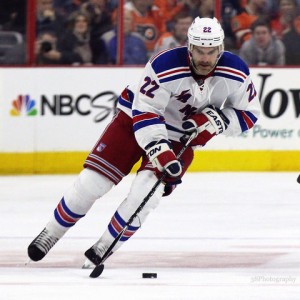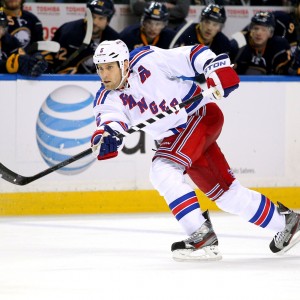Two summers ago the New York Rangers made the decision to sign unrestricted free agent defenseman Dan Boyle to a two-year, $9MM deal. The same day, Anton Stralman left Manhattan to join the Tampa Bay Lightning with a five-year contract worth $22.5MM. Most who follow the team felt the two signings were linked, that the Rangers essentially chose Boyle over Stralman; a decision, which in hindsight didn’t work out well. It’s understandable to look at those choices and draw that same conclusion. Yet that conclusion is erroneous; the Rangers effectively moved on from Stralman the moment the club agreed to a long-term extension with Dan Girardi.
First, Stralman and Boyle were totally different in terms of what they did well. The Rangers coveted Boyle because they felt he would fill their need for a PP QB. The team had been looking for someone to take charge from the point on the man advantage for years. The Blue Shirts finished the 2013-2014 regular season 15th in PP efficiency. The year before they placed 23rd. In the five seasons before joining the Blue Shirts, Boyle placed 16th, 10th, 14th, 7th and 4th in power play points among defensemen. No Ranger blue liner placed in the top 16 since Michael Del Zotto finished 12th during the 2009-2010 campaign. Signing Boyle to boost the man-advantage attack did make sense.

On the other hand, Stralman wasn’t viewed as someone who could help the power play. During the 2013-2014 season, the Rangers used Stralman on the man advantage for just 22:32. That’s a total accumulated in 81 games played that season. Granted, it’s possible or even likely the Rangers missed the boat on their evaluation of Stralman’s abilities as he has tallied 23 PP points in two years since joining Tampa. While not the production of an elite performer it’s still solid.
Regardless of whether the team underestimated Stralman’s capabilities, the team desired to improve their man-advantage and overall offensive attack and decided to pursue Boyle to address those areas. Stralman was someone the team utilized in their top-four, as a right-side defenseman, and who played a majority of his minutes at even strength or killing penalties. After signing Girardi to his six-year, $33MM extension, and with fellow right-handed defenseman Kevin Klein also on the roster, the Blue Shirts had room for only one more right defenseman. With Girardi and Klein around to kill penalties and capable of playing shutdown roles against top competition, the team decided they wanted a more offensively inclined blue liner to augment the lineup and signed Boyle.

The free agent market that summer also dictated the Rangers’ maneuverings. Boyle, because of his age, was limited to short-term offers. Stralman, at 10 years Boyle’s junior was in line for a much longer term, as evidenced by the five-year contract he would ultimately receive. The club had a coming roster crunch with young defenders Dylan McIlrath and Brady Skjei in the pipeline and lots of key contributors approaching free agency in the near future. Since July 1st, 2014 when both Boyle and Stralman inked their free agent deals, the Blue Shirts have had to re-sign centers Derick Brassard and Derek Stepan, winger Mats Zuccarello, while also extending Marc Staal. Those moves accounted for a total of $21.7MM in cap charges. That doesn’t include the need to re-sign Chris Kreider, Kevin Hayes and JT Miller, all of whom are scheduled to be restricted free agents this summer. Boyle’s two-year commitment fit much better in the team’s long range budget.
Signing Boyle made sense on paper for a variety of reasons. And while in hindsight, that signing certainly didn’t work out as hoped, it wasn’t what precluded the club from re-singing Stralman. Dan Girardi’s massive extension is what essentially sealed Stralman’s fate. The moment Girardi inked his new deal, it signaled that unless Stralman would come back for far less than what he was worth on the open market, his days in New York were all but done. Remember, there were reports the club had offered Stralman’s camp a three-year contract in advance of free agency so there was interest in keeping the defender. But the Rangers had no intention keeping both Girardi and Stralman together for half a decade. From an on-ice perspective they filled the same role. For long-range budgetary reasons, it didn’t make sense. Boyle and Stralman together? Perhaps. Boyle and Girardi? Yes. Stralman and Girardi? No, and that is why the Rangers are likely stuck with a severely declining Girardi while Stralman continues to perform well in Florida.